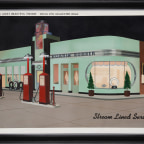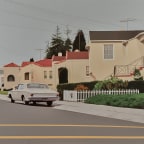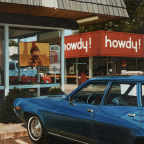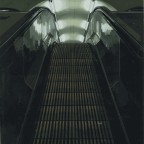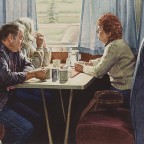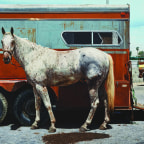Biography
Coined by Louis K. Meisel in 1969, 'Photorealism' describes work by a loose group of artists hailing from the East and West coasts of the United States who based their paintings on photography. These artists embraced the photograph as a subject and incorporate the detached vision of the camera into their work. This gives their paintings an astonishing degree of clarity – a captured moment, fleeting effects of light and shade – that requires significant artistic skill to replicate in paint. The paintings in this group paintings typically depicting scenes of everyday American life in the mid-twentieth century. While each artist's approach is distinct, common subjects include cars, motorcycles, gas stations and symbols of mass consumerism: diners, advertising billboards and neon store signs.
Despite their photographic starting point, these artists are chiefly concerned with paint and the technical challenges of the medium. Photorealists relished capturing reflective surfaces such as glass, chrome and the texture of materials like leather and plastic. Reacting against Abstract Expressionism, which was then dominant in the United States, the artists purported to remove any trace of the human hand, yet hints remain. Photorealist paintings are not, therefore, straight copies of photographs but artistic interpretations. Often, multiple photographs and perspectives are used to create a satisfying composition, with people or objects removed and colours invented; often the original photographs were black and white.
Waddington Custot is focussed on works by the movement's most important protagonists, operating in the years 1968-1985: John Baeder, Robert Bechtle, Charles Bell, Tom Blackwell, Davis Cone, Robert Cottingham, Don Eddy, Richard Estes, Ralph Goings, Ron Kleemann, Richard McLean, David Parrish, John Salt and Ben Schonzeit.
Lire plus-
 Robert Bechtle‘64 Chrysler, 1971oil on canvas48 x 59 3/4 in / 121.9 x 151.8 cm
Robert Bechtle‘64 Chrysler, 1971oil on canvas48 x 59 3/4 in / 121.9 x 151.8 cm -
 Robert CottinghamParking Lot, 1966oil on canvas
Robert CottinghamParking Lot, 1966oil on canvas
43 7/8 x 74 7/8 in / 111.3 x 190.2 cm -
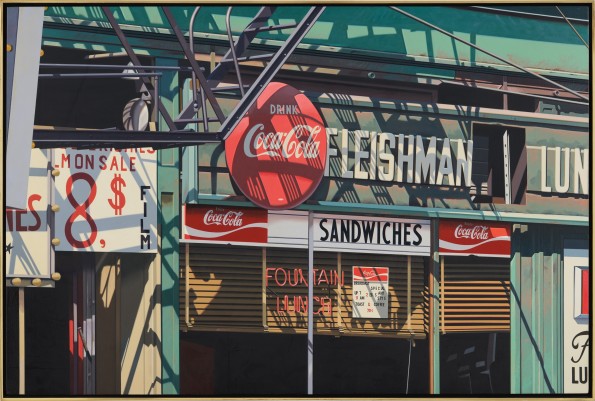 Robert CottinghamFleishman, 1982oil on canvas48 1/8 x 72 in
Robert CottinghamFleishman, 1982oil on canvas48 1/8 x 72 in
122.3 x 183 cm%3Cdiv%20class%3D%22artist%22%3E%3Cspan%20class%3D%22artist%22%3E%3Cstrong%3ERobert%20Cottingham%3C/strong%3E%3C/span%3E%3C/div%3E%0D%3Cdiv%20class%3D%22title%22%3E%3Cem%3EFleishman%3C/em%3E%2C%201982%3C/div%3E%0D%3Cdiv%20class%3D%22medium%22%3Eoil%20on%20canvas%3C/div%3E%0D%3Cdiv%20class%3D%22dimensions%22%3E48%201/8%20x%2072%20in%3Cbr%20/%3E%0A122.3%20x%20183%20cm%3C/div%3E -
 Robert CottinghamRialto, 1985watercolour on paper19 7/8 x 18 in / 50.5 x 45.7 cm%3Cdiv%20class%3D%22artist%22%3E%3Cspan%20class%3D%22artist%22%3E%3Cstrong%3ERobert%20Cottingham%3C/strong%3E%3C/span%3E%3C/div%3E%0D%3Cdiv%20class%3D%22title%22%3E%3Cem%3ERialto%3C/em%3E%2C%201985%3C/div%3E%0D%3Cdiv%20class%3D%22medium%22%3Ewatercolour%20on%20paper%3C/div%3E%0D%3Cdiv%20class%3D%22dimensions%22%3E19%207/8%20x%2018%20in%20/%2050.5%20x%2045.7%20cm%3C/div%3E
Robert CottinghamRialto, 1985watercolour on paper19 7/8 x 18 in / 50.5 x 45.7 cm%3Cdiv%20class%3D%22artist%22%3E%3Cspan%20class%3D%22artist%22%3E%3Cstrong%3ERobert%20Cottingham%3C/strong%3E%3C/span%3E%3C/div%3E%0D%3Cdiv%20class%3D%22title%22%3E%3Cem%3ERialto%3C/em%3E%2C%201985%3C/div%3E%0D%3Cdiv%20class%3D%22medium%22%3Ewatercolour%20on%20paper%3C/div%3E%0D%3Cdiv%20class%3D%22dimensions%22%3E19%207/8%20x%2018%20in%20/%2050.5%20x%2045.7%20cm%3C/div%3E -
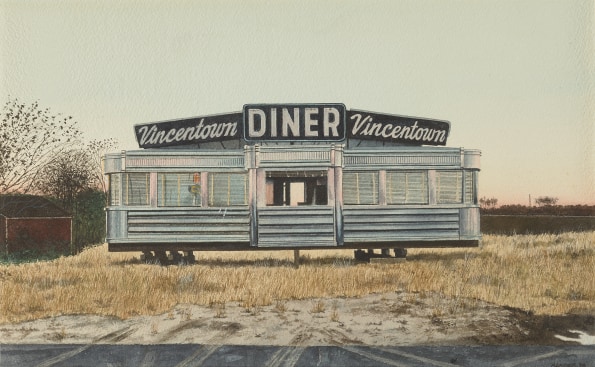 John BaederVincentown Diner, 1974watercolour on paper10 x 16 in / 25.4 x 40.6 cm%3Cdiv%20class%3D%22artist%22%3E%3Cspan%20class%3D%22artist%22%3E%3Cstrong%3EJohn%20Baeder%3C/strong%3E%3C/span%3E%3C/div%3E%0D%3Cdiv%20class%3D%22title%22%3E%3Cem%3EVincentown%20Diner%3C/em%3E%2C%201974%3C/div%3E%0D%3Cdiv%20class%3D%22medium%22%3Ewatercolour%20on%20paper%3C/div%3E%0D%3Cdiv%20class%3D%22dimensions%22%3E10%20x%2016%20in%20/%2025.4%20x%2040.6%20cm%3C/div%3E
John BaederVincentown Diner, 1974watercolour on paper10 x 16 in / 25.4 x 40.6 cm%3Cdiv%20class%3D%22artist%22%3E%3Cspan%20class%3D%22artist%22%3E%3Cstrong%3EJohn%20Baeder%3C/strong%3E%3C/span%3E%3C/div%3E%0D%3Cdiv%20class%3D%22title%22%3E%3Cem%3EVincentown%20Diner%3C/em%3E%2C%201974%3C/div%3E%0D%3Cdiv%20class%3D%22medium%22%3Ewatercolour%20on%20paper%3C/div%3E%0D%3Cdiv%20class%3D%22dimensions%22%3E10%20x%2016%20in%20/%2025.4%20x%2040.6%20cm%3C/div%3E -
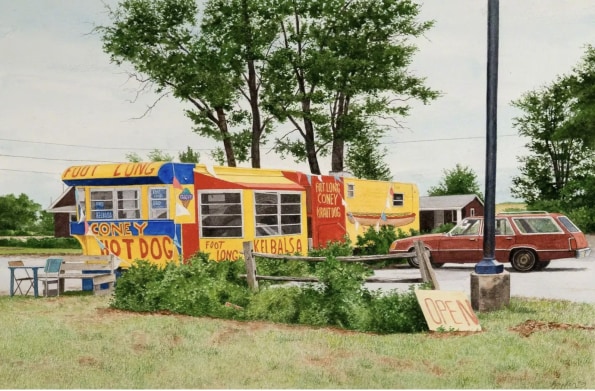 John BaederFoot Long, 2009watercolour on paper22 1/2 x 31 1/4 in / 57.2 x 79.2 cm%3Cdiv%20class%3D%22artist%22%3E%3Cspan%20class%3D%22artist%22%3E%3Cstrong%3EJohn%20Baeder%3C/strong%3E%3C/span%3E%3C/div%3E%0D%3Cdiv%20class%3D%22title%22%3E%3Cem%3EFoot%20Long%3C/em%3E%2C%202009%3C/div%3E%0D%3Cdiv%20class%3D%22medium%22%3Ewatercolour%20on%20paper%3C/div%3E%0D%3Cdiv%20class%3D%22dimensions%22%3E22%201/2%20x%2031%201/4%20in%20/%2057.2%20x%2079.2%20cm%3C/div%3E
John BaederFoot Long, 2009watercolour on paper22 1/2 x 31 1/4 in / 57.2 x 79.2 cm%3Cdiv%20class%3D%22artist%22%3E%3Cspan%20class%3D%22artist%22%3E%3Cstrong%3EJohn%20Baeder%3C/strong%3E%3C/span%3E%3C/div%3E%0D%3Cdiv%20class%3D%22title%22%3E%3Cem%3EFoot%20Long%3C/em%3E%2C%202009%3C/div%3E%0D%3Cdiv%20class%3D%22medium%22%3Ewatercolour%20on%20paper%3C/div%3E%0D%3Cdiv%20class%3D%22dimensions%22%3E22%201/2%20x%2031%201/4%20in%20/%2057.2%20x%2079.2%20cm%3C/div%3E -
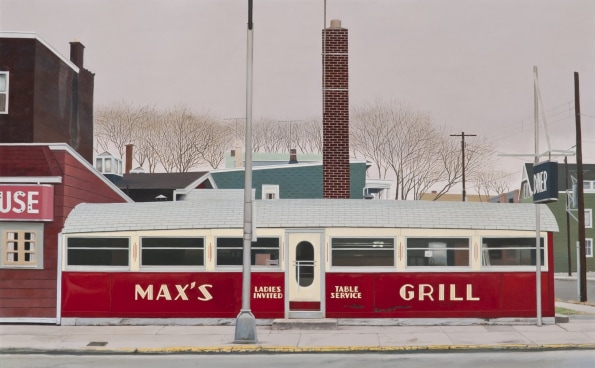 John BaederMax’s Grill, 1974oil on canvas30 1/8 x 48 in / 76.5 x 122 cm
John BaederMax’s Grill, 1974oil on canvas30 1/8 x 48 in / 76.5 x 122 cm -
 Ralph GoingsBlue Napkin Holder, 1978oil on canvas26 x 36 in / 66 x 91.4 cm%3Cdiv%20class%3D%22artist%22%3E%3Cspan%20class%3D%22artist%22%3E%3Cstrong%3ERalph%20Goings%3C/strong%3E%3C/span%3E%3C/div%3E%0D%3Cdiv%20class%3D%22title%22%3E%3Cem%3EBlue%20Napkin%20Holder%3C/em%3E%2C%201978%3C/div%3E%0D%3Cdiv%20class%3D%22medium%22%3Eoil%20on%20canvas%3C/div%3E%0D%3Cdiv%20class%3D%22dimensions%22%3E26%20x%2036%20in%20/%2066%20x%2091.4%20cm%3C/div%3E
Ralph GoingsBlue Napkin Holder, 1978oil on canvas26 x 36 in / 66 x 91.4 cm%3Cdiv%20class%3D%22artist%22%3E%3Cspan%20class%3D%22artist%22%3E%3Cstrong%3ERalph%20Goings%3C/strong%3E%3C/span%3E%3C/div%3E%0D%3Cdiv%20class%3D%22title%22%3E%3Cem%3EBlue%20Napkin%20Holder%3C/em%3E%2C%201978%3C/div%3E%0D%3Cdiv%20class%3D%22medium%22%3Eoil%20on%20canvas%3C/div%3E%0D%3Cdiv%20class%3D%22dimensions%22%3E26%20x%2036%20in%20/%2066%20x%2091.4%20cm%3C/div%3E -
 Ron KleemannPrivate Sanitation, 1976acrylic on paper20 1/8 x 30 1/8 in / 51 x 76.4 cm%3Cdiv%20class%3D%22artist%22%3E%3Cspan%20class%3D%22artist%22%3E%3Cstrong%3ERon%20Kleemann%3C/strong%3E%3C/span%3E%3C/div%3E%0D%3Cdiv%20class%3D%22title%22%3E%3Cem%3EPrivate%20Sanitation%3C/em%3E%2C%201976%3C/div%3E%0D%3Cdiv%20class%3D%22medium%22%3Eacrylic%20on%20paper%3C/div%3E%0D%3Cdiv%20class%3D%22dimensions%22%3E20%201/8%20x%2030%201/8%20in%20/%2051%20x%2076.4%20cm%3C/div%3E
Ron KleemannPrivate Sanitation, 1976acrylic on paper20 1/8 x 30 1/8 in / 51 x 76.4 cm%3Cdiv%20class%3D%22artist%22%3E%3Cspan%20class%3D%22artist%22%3E%3Cstrong%3ERon%20Kleemann%3C/strong%3E%3C/span%3E%3C/div%3E%0D%3Cdiv%20class%3D%22title%22%3E%3Cem%3EPrivate%20Sanitation%3C/em%3E%2C%201976%3C/div%3E%0D%3Cdiv%20class%3D%22medium%22%3Eacrylic%20on%20paper%3C/div%3E%0D%3Cdiv%20class%3D%22dimensions%22%3E20%201/8%20x%2030%201/8%20in%20/%2051%20x%2076.4%20cm%3C/div%3E -
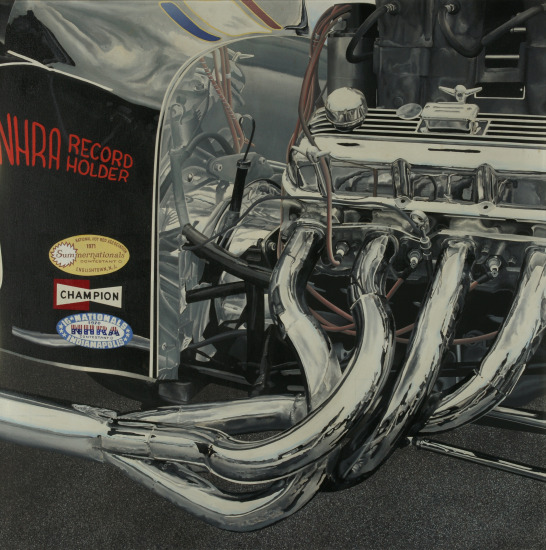 Ron KleemannXmas Tree Series: Green Light, 1971acrylic on canvas48 1/4 x 48 1/8 in / 122.5 x 122.3 cm%3Cdiv%20class%3D%22artist%22%3E%3Cspan%20class%3D%22artist%22%3E%3Cstrong%3ERon%20Kleemann%3C/strong%3E%3C/span%3E%3C/div%3E%0D%3Cdiv%20class%3D%22title%22%3E%3Cem%3EXmas%20Tree%20Series%3A%20Green%20Light%3C/em%3E%2C%201971%3C/div%3E%0D%3Cdiv%20class%3D%22medium%22%3Eacrylic%20on%20canvas%3C/div%3E%0D%3Cdiv%20class%3D%22dimensions%22%3E48%201/4%20x%2048%201/8%20in%20/%20122.5%20x%20122.3%20cm%3C/div%3E
Ron KleemannXmas Tree Series: Green Light, 1971acrylic on canvas48 1/4 x 48 1/8 in / 122.5 x 122.3 cm%3Cdiv%20class%3D%22artist%22%3E%3Cspan%20class%3D%22artist%22%3E%3Cstrong%3ERon%20Kleemann%3C/strong%3E%3C/span%3E%3C/div%3E%0D%3Cdiv%20class%3D%22title%22%3E%3Cem%3EXmas%20Tree%20Series%3A%20Green%20Light%3C/em%3E%2C%201971%3C/div%3E%0D%3Cdiv%20class%3D%22medium%22%3Eacrylic%20on%20canvas%3C/div%3E%0D%3Cdiv%20class%3D%22dimensions%22%3E48%201/4%20x%2048%201/8%20in%20/%20122.5%20x%20122.3%20cm%3C/div%3E -
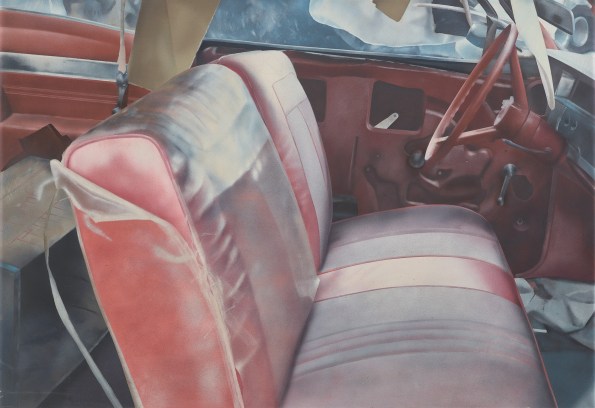 John SaltArrested Vehicle (Silver Upholstery), 1970oil on canvas
John SaltArrested Vehicle (Silver Upholstery), 1970oil on canvas
53 x 77 in / 134.5 x 195.7 cm -
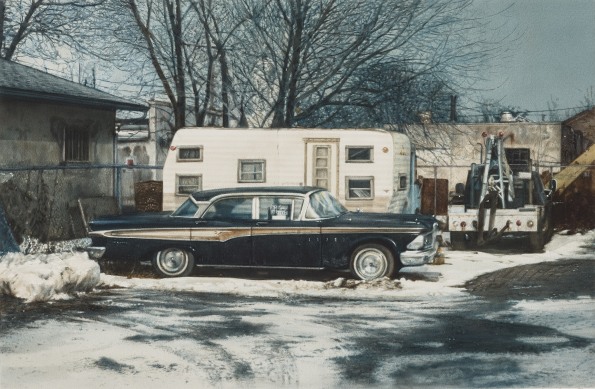 John SaltEdsel in the Snow, 1992watercolour on paper19 1/4 x 26 3/4 in / 48.9 x 67.9 cm%3Cdiv%20class%3D%22artist%22%3E%3Cspan%20class%3D%22artist%22%3E%3Cstrong%3EJohn%20Salt%3C/strong%3E%3C/span%3E%3C/div%3E%0D%3Cdiv%20class%3D%22title%22%3E%3Cem%3EEdsel%20in%20the%20Snow%3C/em%3E%2C%201992%3C/div%3E%0D%3Cdiv%20class%3D%22medium%22%3Ewatercolour%20on%20paper%3C/div%3E%0D%3Cdiv%20class%3D%22dimensions%22%3E19%201/4%20x%2026%203/4%20in%20/%2048.9%20x%2067.9%20cm%3C/div%3E
John SaltEdsel in the Snow, 1992watercolour on paper19 1/4 x 26 3/4 in / 48.9 x 67.9 cm%3Cdiv%20class%3D%22artist%22%3E%3Cspan%20class%3D%22artist%22%3E%3Cstrong%3EJohn%20Salt%3C/strong%3E%3C/span%3E%3C/div%3E%0D%3Cdiv%20class%3D%22title%22%3E%3Cem%3EEdsel%20in%20the%20Snow%3C/em%3E%2C%201992%3C/div%3E%0D%3Cdiv%20class%3D%22medium%22%3Ewatercolour%20on%20paper%3C/div%3E%0D%3Cdiv%20class%3D%22dimensions%22%3E19%201/4%20x%2026%203/4%20in%20/%2048.9%20x%2067.9%20cm%3C/div%3E











